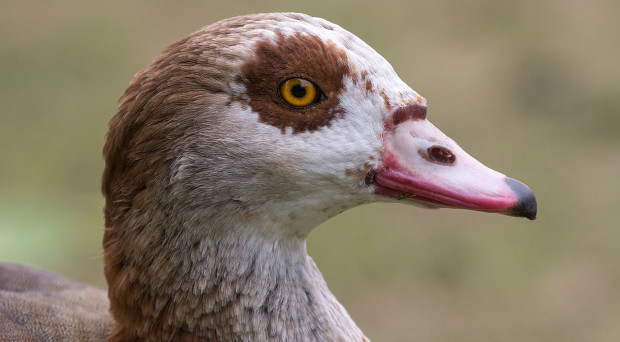
The domestication of Drosophila
Genomic signatures of domestication on neurogenetic genes in Drosophila melanogaster
A considerable body of research exists on the evolution of the species domesticated by humans over the last few thousand years. But what about those species that scientists have domesticated much more recently, such as the classic laboratory model species Drosophila melanogaster?
Craig Stanley Jr. and Rob Kulathinal at Temple University conducted the first study of behavioural differences between wild and lab-strains of Drosophila. They confirmed that lab-reared flies are considerably less active than wild-caught flies. Genomic comparisons of five lab strains with the wild-type genome suggests these changes are not just due to accumulations of deleterious mutations caused by inbreeding. Instead, a distinct pattern of genetic changes across the five strains supports the idea that these traits have been selected for. Early geneticists may have unconsciously selected for flies with lower activity by breeding the individuals that were easiest for them to catch and manipulate, creating the distinct domestic phenotype we see today.
Rob Kulathinal discussed the research in more detail on our blog in January.
Survival of the oldest
Why are some species older than others? A large-scale study of vertebrates
Why do some species persist for longer than others? ‘Living fossils’ like the coelacanth and the frilled shark have survived for tens of millions of years, yet many other species arise and become extinct in far shorter periods of time. A team of researchers at the University of Lausanne sought to discover common factors shared by long-lived species.
Comparing 600 vertebrate species, the researchers compared species age with a number of life-history factors, while controlling for evolutionary relationships. Species with varying colored individuals, those that give birth to live young, and/or those that live at low latitudes were the most resilient to past environmental changes.
Aside from satisfying our evolutionary curiosities, this research could also be useful to conservationists. Species which have persisted through long periods of past climatic changes will, presumably, be more resilient to future climatic changes. Conversely then, we can predict that species lacking the life-history factors common to many long-lived species are potentially the most vulnerable to the effects of future climate change.
Hawk vs. goose
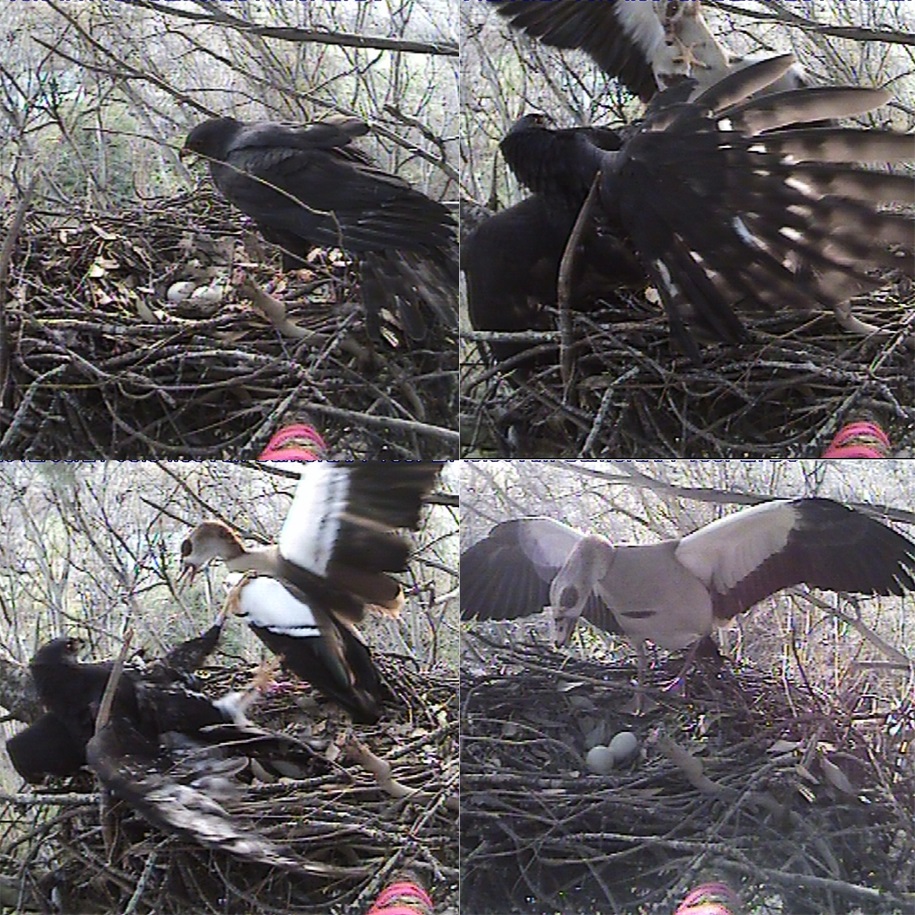
Is multiple nest building an adequate strategy to cope with inter-species nest usurpation?
The black sparrowhawk has successfully colonised the urban environment of South Africa’s Cape Town in recent years, with around 50 pairs now breeding there. Their new environment has brought challenges however, including a particularly aggressive neighbour: the Egyptian goose. Egyptian geese find black sparrowhawk nests ideal to lay their own eggs in and will often take over occupied nests; at twice their size, and with an aggressive temperament, there is little a sparrowhawk can do to prevent a goose from usurping their nest.
In response, sparrowhawks have developed a new tactic to deal with covetous geese: build a lot of nests. Sparrowhawks in territories that had previously experienced nest usurpation by geese built significantly more nests than pairs with no experience of usurpation. This tactic seems to be successful; sparrowhawks that build multiple nests largely overcome the deficit in reproductive success experienced by other individuals breeding in territories with geese activity that do not build multiple nests.
We discussed this research in more detail on our blog in May.
Genetic tug-of-war linked to evolution of gay beetles
Same-sex sexual behaviors (SSBs) do not readily conform to classical evolutionary models: what adaptive benefit can such behavior have? SSBs are often explained as perception errors; males mistake other males for females and attempt to mate with them. This is less of a persuasive argument in species, like the seed beetle, where females also engage in SSBs. Instead, researchers at the University of Uppsala presented evidence that SSBs in these beetles reflect an underlying evolutionary tug-of-war between the sexes.
The researchers selectively bred beetle lines that exhibited higher rates of SSBs. Both males and females in these lines showed higher mobility than wild-type beetles. For males this resulted in higher reproductive success, presumably as they could mate with more females. For females though, the opposite was true; higher mobility was linked to lower reproductive success.
This suggests that there is a pleiotropic effect underlying the evolution of SSBs; the same genes linked to SSBs are also linked to increased mobility and so, for males, can be adaptive. Presumably this evolutionary benefit for males outweighs the damage it does to their sisters, who show SSBs without any accompanying adaptive benefits.
Female chimps give out mixed messages

In many primate species, females signal their willingness to mate through sexual swellings of their genitalia. In most primates these sexual swellings are an honest signal of a female’s ability to conceive, enabling males to focus their reproductive efforts on receptive females. In bonobo chimps however, these signals appear to be rather less honest.
Researchers tracked the timing and duration of sexual swellings in wild bonobo females and, by also collecting urine samples during this time, examined their correlation with the actual time of ovulation. Duration of sexual swellings varied considerably (from 1-31 days) and, moreover, there was no correlation between ovulation and the maximal swelling period.
In bonobos then, female sexual swellings are not an honest signal to males. This may explain why bonobo males do not engage in aggressive guarding of females during their swelling period, as is the case with other primates. In turn, this could be one of the reasons behind bonobo’s famously peaceful society: lies help to keep the peace.
Lead author Pamela Heidi Douglas discussed her research in more detail on our blog in June.
Crickets have solid social networks
Wild cricket social networks show stability across generations
The study of animal social networks continues to grow, with research across a range of taxa addressing a wealth of different questions. One limitation of these studies is that they generally cannot determine if social network structures persist across multiple generations. If they do not, then evolutionary processes, such as the evolution of cooperation, could not take place; a cooperative strategy that exploits aspects of the social network in one generation might not be successful in the next, preventing it from persisting in the population.
The difficulty of testing cross-generation social network stability partly arises from the species being studied, often long-lived mammals like whales and primates. To follow the social structure of these species through multiple generations would be a considerable challenge. This is why the research group of Tom Tregenza at Exeter University focused on crickets for their study of social network stability.
Do crickets have social networks? Yes, in the sense of networks of social interactions between individuals that either mate with or fight each other. Tracking a population of wild crickets across eight generations, the researchers found that the social networks in any given year were able to predict the structure of networks in other years, regardless of how far apart those years were in time. Thus, it appears that cricket social structures are indeed persistent across generations and that evolutionary processes relying on network structure could take place.
While the researchers caution that their methods may not scale up to larger population sizes, this work was a big step forward for the study of animal social networks.
Teeth, teeth everywhere
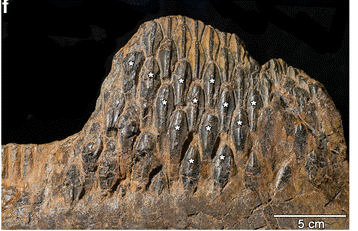
Ontogeny reveals function and evolution of the hadrosaurid dinosaur dental battery
Hadrosaur dinosaurs, the dominant herbivores of the late Cretaceous period, had arguably the most complex dentition of any vertebrate that has ever existed. Each jaw ramus contained a battery of up to 300 teeth consisting of multiple generations of small, vertically-stacked teeth interlocked with neighbouring teeth. Surprisingly though, the development of these batteries conforms to a simple evolutionary model.
Aaron LeBlanc and colleagues undertook the first comprehensive, tissue-level study of dental ontogeny in hadrosaurids. They made use of modern techniques to create a three-dimensional view of the arrangements of the enamel and dental attachment tissues in unworn teeth in order to understand the development and function of the dental battery.
Their findings show that the complex teeth batteries did not involve the evolution of any unique dental tissues. Instead the novelty of hadrosaur dentition came in how ancestral reptilian dental tissues were utilised in the interactions between individual teeth and between families of teeth; in a way somewhat analogous to how medieval chain mail was constructed.
Male and female cats respond differently to distressed kittens

Female cats, but not males, adjust responsiveness to arousal in the voice of kittens
Like many mammals, when separated from their mother kittens begin to cry. Previous research by a team led by Marina Scheumann at Hannover University demonstrated that the auditory content of these messages varies between a ‘low arousal’ state (when a kitten is just spatially separated from its mother) and a ‘high arousal’ state (when a kitten is also manipulated by the researchers). In this new paper, they looked to see if these changes in the kitten distress call are actually detectable by their mothers.
Female cats did indeed modify their response to recordings of kitten cries according to their urgency, responding around 10% faster to high arousal calls. Surprisingly, experience with actually raising kittens did not affect this; virgin female cats responded as quickly as experienced mothers did.
Another surprising finding of the study was that male cats – who play no role in rearing offspring – reacted as quickly as females to cries of kittens in the low arousal state. However, unlike females, male cats did not respond more quickly to urgent, high arousal calls. This implies an inbuilt genetic difference in how the sexes respond to the emotional content of a kitten distress call.
In the blink of an evolutionary eye
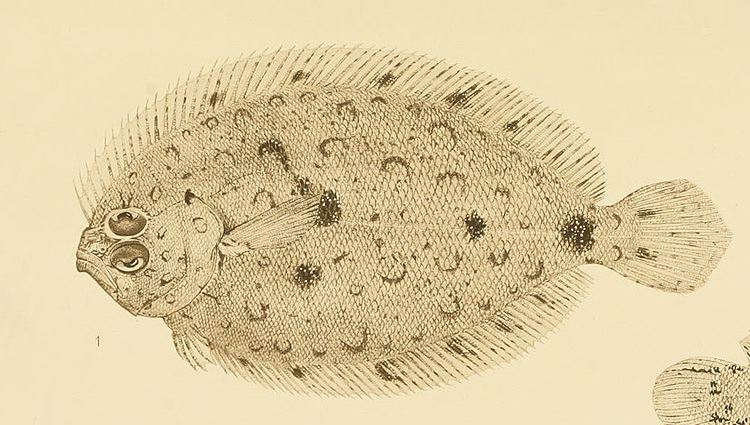
Flatfish might appear to possess one of the more unique evolutionary adaptations, an extreme cranial asymmetry resulting in both eyes being on one side of their head. Yet some recent phylogenetic studies had suggested that this adaptation evolved independently in two groups of flatfish, although other studies supported the traditional view that the cranial asymmetry evolved only once in an ancestor shared by all modern flatfish.
This confusion mainly results from uncertainties in the evolutionary relationships of the wider fish group flatfish belong to, the caringimorpharia. A team of researchers led by Matt Friedman at Oxford University used ultra-conserved DNA elements to produce the most robust phylogeny of the caringimorpharia yet assembled.
This new evolutionary tree supports a single evolutionary origin of the (indeed unique) flatfish cranial asymmetry. It also suggests that the reason for the conflicting results of previous studies was the remarkably quick speed at which this adaptation evolved; just 2.9 million years. Flatfish seem to be remarkable not just for their unique morphology but also for having undergone such drastic morphological changes in nothing more than the blink of an evolutionary eye.
We discussed this research in more detail on our blog in October.
The cryptic Japanese tree frog
Is the Japanese tree frog actually Japanese? The frog, going under the scientific name Hyla japonica, is certainly found in Japan, but also in other parts of East Asia like Russia, China, and South Korea. Recently however, some have suggested that H. japonica populations in mainland Asia and in Japan should be considered as two or more separate species.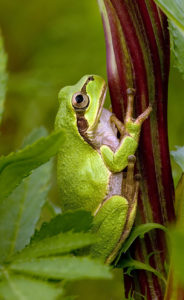
A multi-national team of researchers, including collaborators from Japan, Germany, Switzerland, Russia, South Korea and China, pooled genetic data on H. japonica and related species from across the East-Asian peninsula. This allowed them to determine both the genetic similarities among these disparate populations and to infer how the evolution and distribution of these frogs was affected by past climatic changes and major geological events.
They found that current patterns of diversity were likely triggered by tectonic activities during the Miocene (5-23 million years ago) and by more recent glacial periods, which caused the formation and disappearance of land-bridges between Japan and the main Asian continent. They also found evidence for cryptic speciation within H. japonica, with significant enough genetic diversity between Japanese and mainland populations for the authors to argue they should indeed be considered separate species.
Curiously, due to the arcane rules of taxonomy, if Hyla japonica were to be split into multiple species the name japonica – literally meaning ‘things related to Japan’ – might have to be assigned to the mainland frog population. So the Japanese tree frog might end up not being Japanese after all.
And a few more…
A few more fascinating papers published in BMC Evolutionary Biology this year which we covered on the BMC series blog:
A new innovation piloted by the BMC Series in 2016 were video abstracts of selected papers. BMC Evolutionary Biology saw three papers highlighted this way, with gopher evolution, the discovery of the first salmonfly fossil and the evolution of bitter taste in New World monkeys all covered.
In January Alex Cagan discussed his research on the role of genes involved in the fight-or-flight response in dog domestication.
In February we uncovered new research on how bygone Asian dragons once invaded an independent India.
In April, Paleocast’s Dave Marshall invited us to meet Jorgi and Birgit, scorpion lovers from the Permian period.
We discussed a love-dart at the heart of sexual conflict in snails, in this blog from May.
How did the tiger shark lose its placenta? we asked in June.
Pedro Romero discussed his study on the genetic changes behind the evolutionary transition from sea to land, finding evidence of selection on the same genes in multiple species that independently made this journey.
Solving a riddle that puzzled Darwin, we looked at research asking why the flora of the Azores Islands is so much less diverse than that of other island archipelagos?
Finally, in November the researchers behind a study on the demographic history of the turtle dove explained how their research could help avoid an “unexpected” extinction of this species.
Comments